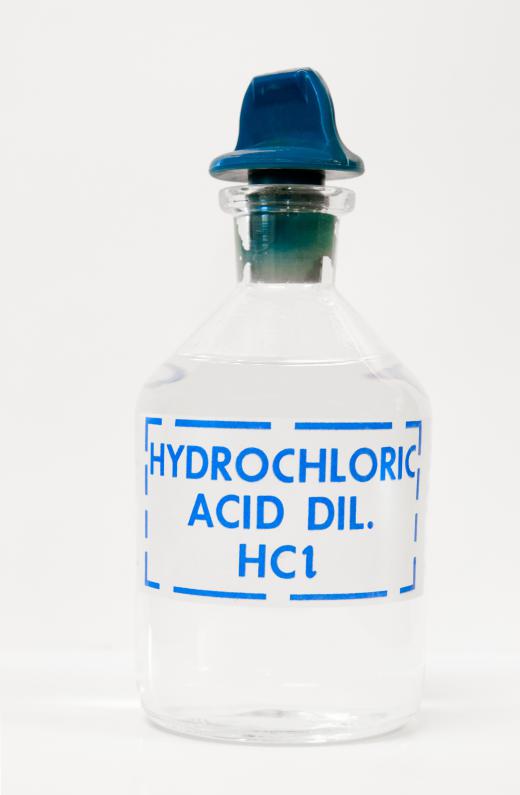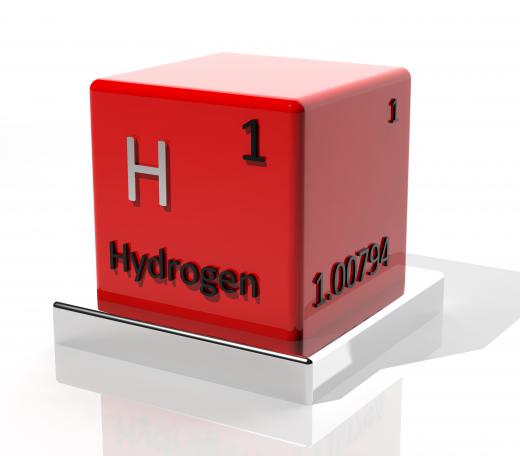What is Hydrochloric Acid?
 Karyn Maier
Karyn Maier
Hydrochloric acid (HCL) is a colorless and highly pungent solution of hydrogen chloride and water. Once commonly referred to as muriatic acid or spirit of salt, this acid is a highly corrosive chemical compound with several applications in industry. It is also found in diluted amounts in the stomach of humans and animals as gastric acid.
This substance was first described by the 8th century Arab alchemist Jabir ibn Hayyan. In the 13th century, alchemists employed the Jabir’s theory to locate the "philosopher's stone" based on his conclusion that his discovery could turn ordinary metals into gold. Jabir’s method of combining hydrochloric acid with nitric acid, which he called aqua regia, could indeed dissolve and separate gold and silver from metal alloys and mineral ores. In fact, HCL is still used for precious metal reclamation today.

In the industry sector, hydrochloric acid is produced by dissolving hydrogen chloride in water. This process first began during the Industrial Revolution in Europe, where there was a great need to inexpensively produce soda ash on a large scale. Using a combination of limestone, sulfuric acid, and coal, salt was converted into soda ash, leaving behind hydrogen chloride as a by-product. At first, this by-product was released into the air, but under pressure of the British Alkali Act of 1863, manufacturers were forced to dissolve the hydrogen chloride in water, which produced the acid.

Today, this acid is used in great quantity to produce organic compounds, such as vinyl chloride to make polyvinyl chloride (PVC) and methylene diphenyl diisocyanate to make polyurethane. It is also used to produce bisphenol A, activated carbon, and ascorbic acid. Other uses include the manufacture of leather goods, pharmaceutical products, and various household cleaning solutions.

Important to the oil production industry, HCL is used in a process known as oil-well acidization. This process involves injecting the acid into the cavities of oil wells to dissolve away sections of rock, leaving an open column behind. Ultimately, the method serves to accelerate oil production from the well.
Extreme care must be taken when handling hydrochloric acid. In high concentrations, it releases an acid mist into the air, and both the aqueous solution and the vapor are corrosive to skin and mucous membranes. It also forms chlorine, a toxic gas, when combined with bleach or potassium permanganate. To avoid injury or irritation when working with this acid, chemical retardant clothing should be worn, in addition to PVC gloves and protective eyewear.
AS FEATURED ON:
AS FEATURED ON:















Discussion Comments
Regarding gelatin: cow bones are rarely used for large scale production of food grade gelatin; they are (or rather were) used almost exclusively to make what was called ossine gelatin for the photographic industry. They used an alkali rather than acid process to extract as pure a gelatin as possible since any residual sulphur compounds would affect the film emulsion sensitivity. Acid production of gelatin is definitely used for other gelatin needs, but usually hog hides and organs high in collagen are used.
Thanks for the info I needed for use with a muriatic acid project.
what is the advantage of HCl over any other acid when it is used for acidizing processes in the oil industry?
@ aplenty- Steel manufacturers process iron ore with hydrochloric acid to create the steel alloys that are in our cars, buildings, bikes, and bridges. Hydrochloric acid is also used to manufacture batteries and fireworks. Another food application of hydrochloric acid is in the processing of sugar cane to sugar.
Hydrochloric acid is a very versatile chemical, but because it is so corrosive, it can be very dangerous to handle. When working with this caustic acid, it is always a good idea to read the hydrochloric acid MSDS. Handling it improperly can result in serious burns, injury, or death.
@ aplenty- There are plenty of hydrochloric acid uses. One use of the uses that affects you every day is the processing of gelatin. Many processed foods contain gelatin, which is simply cow bone chips soaked in hydrochloric acid. The hydrochloric acid bath is a crucial process in the processing of the cow bones to extract the collagen to make the gelatin.
You will find gelatin in all kinds of foods ranging from ice cream and marshmallows, to yogurts and preserved meats. Gelatin is also used to make film and adhesives.
What are some other uses for hydrochloric acid besides making plastics and processing petroleum products?
Post your comments